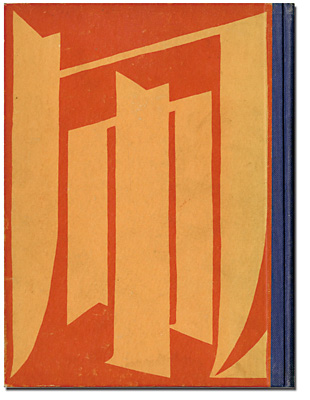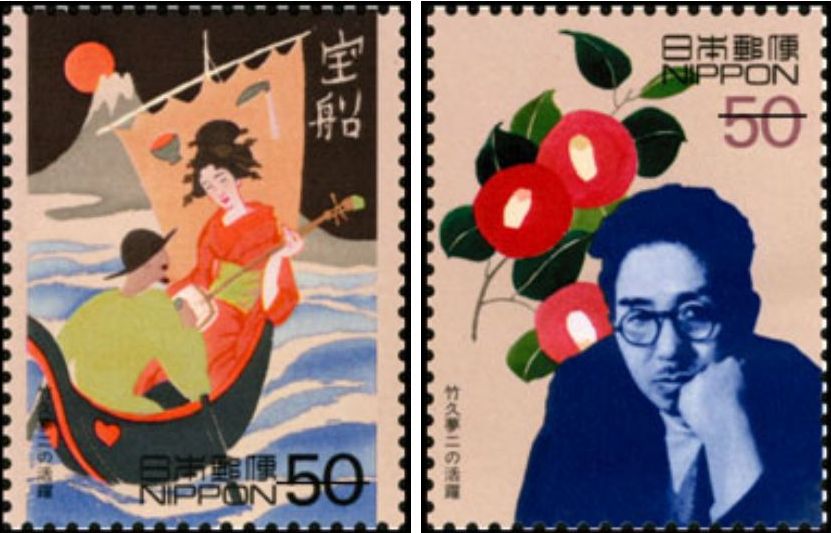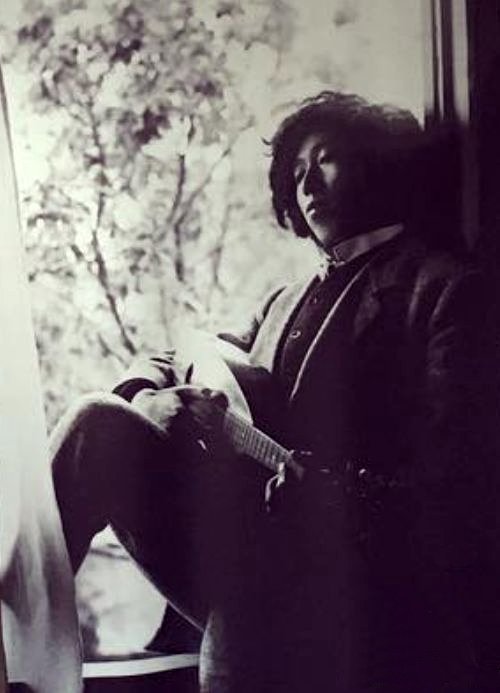| |
TAKEHISA Yumeiji
|
|
Artist – TAKEHISA
Yumeji (竹久 夢二) was born 1884. During his studies from 1902 at
the technical school in Tōkyō (precursor to Waseda
University), his drawings were published in the newspaper
Yomiuri Shimbun e.g. printed sheets. From 1905, through the
mediation of a friend, he was able to regularly make drawings
and frontispices for the printed matter of the Heiminsha
Publishing House.
Yumeiji
left behind numerous bijin-ga,
lyrical works, poems and songs. He is a representative painter
of the Taisho romance, and was sometimes called "Ukiyo-e
artist of the Taisho era". He also
made illustrations for children's magazines and poetry,
created poems, songs, and fairy tales. His three-stanza poem
"Yoimachigusa" ("宵待草", Night Primrose) was quite popular.
Especially the versions of the Manchuria born Yoshiko
Yamaguchi (山口 淑子, やまぐち よしこ, 1920-2014) aka Lee Kaoan (aka
Shirley Yamaguchi, Li Hsiang-lan, pen name Yoshiko Otaka,
later an LDP Diet Member), were smash hits all over South East
Asia. Yumeiji is also one of the pioneers of modern graphic
design in Japan, having designed many books, advertising
materials, daily miscellaneous goods, and even yukata. He was one of the
leading sosaku-hanga
artists of his time.
 |
| Yumeji Children's Song
Collection "The Kite" ("夢二童謡集 凧") 1st edition, Kenkyusha Publishing (研究社), 1926 (Taisho 15, 大正15年) still popular in the 2020ies |
Yumeji increasingly depended on commercial work following the
Great Kanto Earthquake of September 1923. Many of his "Yumeji
Takehisa Bijin-ga" are based on his own unique aesthetic
sense, and are drawn using Japanese painting techniques
(remaining in the style of shafts and even folding screens),
as well as female figures using Western painting (oil on
canvas) techniques and landscape paintings. Within this
context he is also a kind of representative of the nihonga style of
painting. He tried various forms of expression, but
rather, they were mostly evaluated in posterity, and not at
that time. The covers of printed books, magazine
frontispices, and advertising art were quite popular,
and he was in the limelight in the form of popularity. At one
point he seemed to have a longing for the Tokiyo Central Art
Gallery, but he was not accepted, and he sought a new way of
art in the field for the rest of his life.
In terms of the movement of the world, various artistic traits of thoughts are mixed in his painting style at that time, and in this sense, he was in the midst of the indefinite period of a fetal artistic movement. Yumeji also paid attention to the dawn of design as a new applied art against the backdrop of the expansion of consumer life due to the flowering of popular culture in civic culture. In the latter part of his life, as a talented designer, he had the idea that he should aim for art linked to life or integrate with industry, and rather actively created commercial art. It seems that he was drawing the concept of graphic design. The concept of the Harunayama Industrial Art Research Institute and the desire to visit Europe and the United States seem to support this train of thought.
In terms of the movement of the world, various artistic traits of thoughts are mixed in his painting style at that time, and in this sense, he was in the midst of the indefinite period of a fetal artistic movement. Yumeji also paid attention to the dawn of design as a new applied art against the backdrop of the expansion of consumer life due to the flowering of popular culture in civic culture. In the latter part of his life, as a talented designer, he had the idea that he should aim for art linked to life or integrate with industry, and rather actively created commercial art. It seems that he was drawing the concept of graphic design. The concept of the Harunayama Industrial Art Research Institute and the desire to visit Europe and the United States seem to support this train of thought.
After his death he was neary forgotten, but was rediscovered in the 1960s. The Japan Post Office dedicated a stamp to him with the well-known image "Kurofuneya". Three museums compete with each other. The Yumeiji Art Museum (夢二郷土美術館, Yumeji kyōdo bijutsukan) in Okayama, and in Tokyo the Yumeji Takehisa Museum (夢二美術館, Yumeji Bijutsukan), as well as the Yumeji Takehisa Ikaho Memorial Hall (竹久夢二伊香保記念館, Takehisa Yumeji Ikaho Kinenkan).

TAKEHISA-Yumeiji-Stamps
1729j Sakura-Cataog-Nr. Osaka Central Post Office, 1999-10-22
1729j Sakura-Cataog-Nr. Osaka Central Post Office, 1999-10-22
Personal
life - TAKEHISA Yumeiji's
childhood name was Shigejirō (Mojiro, 茂次郎). He was the son
of a sake merchant in Oku (now the Okuchō district of
Setouchi), Okayama Prefecture. From 1902 on he
used the first name Yumeji. He led a bohemian life, forming
closer bonds with some of his models and a longlasting
on-off marriage with a young widowed postcard shop owner Kishi Tamaki
(岸 他万喜, 1882~1945). Tamaki was previously
married to an early died artist painter, with whom she had
two children, Tamaki has
given birth to three children with Yumeji through
marriage and cohabitation phases. In May
1931 Yumeji traveled to California where he had exhibitions
and lectures. From there he traveled in September 1932 on
board the German cargo ship Takoma through the Panama Canal
to Hamburg, and stayed two months in Berlin. He visited
various European countries, always drawing diligently. After
returning to Japan in late 1933, he acquired tuberculosis
and died the following year in a sanatorium in Nagano on
September 1st in 1934. His grave is in Zōshigaya Cemetery,
Tokyo.
Aliases - Shigejirō (Mojiro, 茂次郎) as childhood name, from 1903 he used Yumeiji (夢二) as his personal name
Disciples - no known disciples
Aliases - Shigejirō (Mojiro, 茂次郎) as childhood name, from 1903 he used Yumeiji (夢二) as his personal name
Disciples - no known disciples
Copyright 2008 ff: Hans P. Boehme
